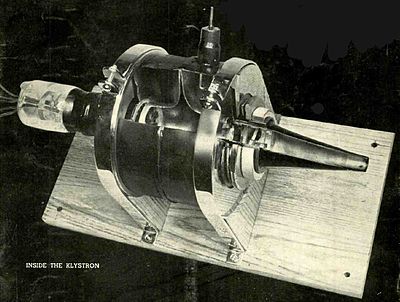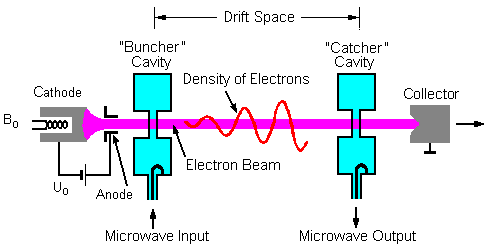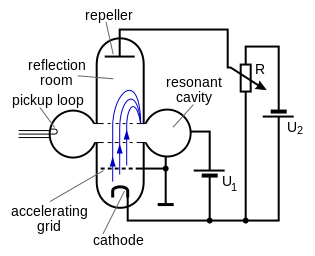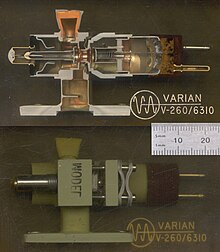Klystron
This article needs additional citations for verification. (January 2013) |

A klystron is a specialized linear-beam
In a klystron, an
A reflex klystron is an obsolete type in which the
The name klystron comes from the Greek verb κλύζω (klyzo) referring to the action of waves breaking against a shore, and the suffix -τρον ("tron") meaning the place where the action happens.[3] The name "klystron" was suggested by Hermann Fränkel, a professor in the classics department at Stanford University when the klystron was under development.[4]
History

The klystron was the first significantly powerful source of radio waves in the
The work of physicist
During the Second World War, the Axis powers relied mostly on (then low-powered and long wavelength) klystron technology for their radar system microwave generation, while the Allies used the far more powerful but frequency-drifting technology of the cavity magnetron for much shorter-wavelength centimetric microwave generation. Klystron tube technologies for very high-power applications, such as synchrotrons and radar systems, have since been developed.
Right after the war,
Operation
Klystrons amplify RF signals by converting the kinetic energy in a DC electron beam into radio frequency power. In a vacuum, a beam of electrons is emitted by an electron gun or thermionic cathode and accelerated by high-voltage electrodes (typically in the tens of kilovolts).
This beam passes through an input
To reinforce the bunching, a klystron may contain additional "buncher" cavities.
The beam then passes through a "drift" tube, in which the faster electrons catch up to the slower ones, creating the "bunches", then through a "catcher" cavity.
In the output "catcher" cavity, each bunch enters the cavity at the time in the cycle when the electric field opposes the electrons' motion, decelerating them. Thus the kinetic energy of the electrons is converted to potential energy of the field, increasing the amplitude of the oscillations. The oscillations excited in the catcher cavity are coupled out through a coaxial cable or waveguide.
The spent electron beam, with reduced energy, is captured by a collector electrode.
To make an oscillator, the output cavity can be coupled to the input cavity(s) with a coaxial cable or waveguide. Positive feedback excites spontaneous oscillations at the resonant frequency of the cavities.
Two-cavity klystron

The simplest klystron tube is the two-cavity klystron. In this tube there are two microwave cavity resonators, the "catcher" and the "buncher". When used as an amplifier, the weak microwave signal to be amplified is applied to the buncher cavity through a coaxial cable or waveguide, and the amplified signal is extracted from the catcher cavity.
At one end of the tube is the hot cathode which produces electrons when heated by a filament. The electrons are attracted to and pass through an anode cylinder at a high positive potential; the cathode and anode act as an electron gun to produce a high velocity stream of electrons. An external electromagnet winding creates a longitudinal magnetic field along the beam axis which prevents the beam from spreading.
The beam first passes through the "buncher" cavity resonator, through grids attached to each side. The buncher grids have an oscillating AC potential across them, produced by standing wave oscillations within the cavity, excited by the input signal at the cavity's
Beyond the buncher grids is a space called the drift space. This space is long enough so that the accelerated electrons catch up with electrons that were decelerated at an earlier time, forming "bunches" longitudinally along the beam axis. Its length is chosen to allow maximum bunching at the resonant frequency, and may be several feet long.
The electrons then pass through a second cavity, called the "catcher", through a similar pair of grids on each side of the cavity. The function of the catcher grids is to absorb energy from the electron beam. The bunches of electrons passing through excite standing waves in the cavity, which has the same resonant frequency as the buncher cavity. Each bunch of electrons passes between the grids at a point in the cycle when the exit grid is negative with respect to the entrance grid, so the electric field in the cavity between the grids opposes the electrons motion. The electrons thus do work on the electric field, and are decelerated, their kinetic energy is converted to electric potential energy, increasing the amplitude of the oscillating electric field in the cavity. Thus the oscillating field in the catcher cavity is an amplified copy of the signal applied to the buncher cavity. The amplified signal is extracted from the catcher cavity through a coaxial cable or waveguide.
After passing through the catcher and giving up its energy, the lower energy electron beam is absorbed by a "collector" electrode, a second anode which is kept at a small positive voltage.
Klystron oscillator
An
Multicavity klystron
In all modern klystrons, the number of cavities exceeds two. Additional "buncher" cavities added between the first "buncher" and the "catcher" may be used to increase the gain of the klystron or to increase the bandwidth.[10]
The residual kinetic energy in the electron beam when it hits the collector electrode represents wasted energy, which is dissipated as heat, which must be removed by a cooling system. Some modern klystrons include depressed collectors, which recover energy from the beam before collecting the electrons, increasing efficiency. Multistage depressed collectors enhance the energy recovery by "sorting" the electrons in energy bins.
Reflex klystron


The
In the reflex klystron the electron beam passes through a single resonant cavity. The electrons are fired into one end of the tube by an electron gun. After passing through the resonant cavity they are reflected by a negatively charged reflector electrode for another pass through the cavity, where they are then collected. The electron beam is velocity modulated when it first passes through the cavity. The formation of electron bunches takes place in the drift space between the reflector and the cavity. The voltage on the reflector must be adjusted so that the bunching is at a maximum as the electron beam re-enters the resonant cavity, thus ensuring a maximum of energy is transferred from the electron beam to the RF oscillations in the cavity. The reflector voltage may be varied slightly from the optimum value, which results in some loss of output power, but also in a variation in frequency. This effect is used to good advantage for automatic frequency control in receivers, and in frequency modulation for transmitters. The level of modulation applied for transmission is small enough that the power output essentially remains constant. At regions far from the optimum voltage, no oscillations are obtained at all.[12] There are often several regions of reflector voltage where the reflex klystron will oscillate; these are referred to as modes. The electronic tuning range of the reflex klystron is usually referred to as the variation in frequency between half power points—the points in the oscillating mode where the power output is half the maximum output in the mode.
Modern semiconductor technology has effectively replaced the reflex klystron in most applications.
Gyroklystron
The gyroklystron is a microwave amplifier with operation dependent on the cyclotron resonance condition. Similarly to the klystron, its operation depends on the modulation of the electron beam, but instead of axial bunching the modulation forces alter the cyclotron frequency and hence the azimuthal component of motion, resulting in phase bunches. In the output cavity, electrons which arrive at the correct decelerating phase transfer their energy to the cavity field and the amplified signal can be coupled out. The gyroklystron has cylindrical or coaxial cavities and operates with transverse electric field modes. Since the interaction depends on the resonance condition, larger cavity dimensions than a conventional klystron can be used. This allows the gyroklystron to deliver high power at very high frequencies which is challenging using conventional klystrons.
Tuning

Some klystrons have cavities that are tunable. By adjusting the frequency of individual cavities, the technician can change the operating frequency, gain, output power, or bandwidth of the amplifier. No two klystrons are exactly identical (even when comparing like part/model number klystrons). Each unit has manufacturer-supplied calibration values for its specific performance characteristics. Without this information the klystron would not be properly tunable, and hence not perform well, if at all.
Tuning a klystron is delicate work which, if not done properly, can cause damage to equipment or injury to the technician due to the very high voltages that could be produced. The technician must be careful not to exceed the limits of the graduations, or damage to the klystron can result. Other precautions taken when tuning a klystron include using nonferrous tools. Some klystrons employ permanent
Precautions are routinely taken when transporting klystron devices in aircraft, as the intense magnetic field can interfere with magnetic navigation equipment. Special overpacks are designed to help limit this field "in the field," and thus allow such devices to be transported safely.
Optical klystron
The technique of amplification used in the klystron is also being applied experimentally at optical frequencies in a type of laser called the free-electron laser (FEL); these devices are called optical klystrons.[13] Instead of microwave cavities, these use devices called undulators. The electron beam passes through an undulator, in which a laser light beam causes bunching of the electrons. Then the beam passes through a second undulator, in which the electron bunches cause oscillation to create a second, more powerful light beam.[13]
Floating drift tube klystron
The floating drift tube klystron has a single cylindrical chamber containing an electrically isolated central tube. Electrically, this is similar to the two cavity oscillator klystron with considerable feedback between the two cavities. Electrons exiting the source cavity are velocity modulated by the electric field as they travel through the drift tube and emerge at the destination chamber in bunches, delivering power to the oscillation in the cavity. This type of oscillator klystron has an advantage over the two-cavity klystron on which it is based, in that it needs only one tuning element to effect changes in frequency. The drift tube is electrically insulated from the cavity walls, and DC bias is applied separately. The DC bias on the drift tube may be adjusted to alter the transit time through it, thus allowing some electronic tuning of the oscillating frequency. The amount of tuning in this manner is not large and is normally used for frequency modulation when transmitting.
Applications
Klystrons can produce far higher microwave power outputs than
See also
References
- ^ a b Pond, Norman H. "The Tube Guys". Russ Cochran, 2008 p.31-40
- ^ ISBN 978-1608071845.
- ^ .
- ^ Varian, Dorothy. "The Inventor and the Pilot". Pacific Books, 1983 p. 189
- ^ Varian, Dorothy. The Inventor and the Pilot. Pacific Books, 1983 p. 187
- ^ George Caryotakis (November 18, 1997). "Invited paper: The Klystron: A microwave source of surprising range and endurance" (PDF). American Physics Society: Division of Plasma Physics Conference, Pittsburgh, PA. Stanford, CA: Stanford SLAC. Archived from the original (PDF) on September 24, 2015. Retrieved September 18, 2012.
- ISBN 0674028791, pp. 122,123
- ^ "CAMD Upgrades to Solid State RF". www.lsu.edu.
- ^ "CERN and Canon demonstrate efficient klystron". CERN Courier. September 5, 2022.
- ISBN 978-81-7758-353-3
- ^ "V- 260, Tube V-260; Röhre V- 260 ID35571, Reflex Klystron". www.radiomuseum.org. Retrieved 2019-12-03.
- ISBN 978-81-7758-353-3
- ^ PMID 9907460. Retrieved June 24, 2014.
- Bibcode:2002rrs..book..869C.
- ^ "PopSci's Best of What's New 2007". Popsci.com. Archived from the original on 2009-03-16. Retrieved 2010-02-28.
- ^ "PopSci's Best of What's New 2007". Popsci.com. Archived from the original on 2010-03-02. Retrieved 2010-02-28.
- ^ US Patent 7629497 - Microwave-based recovery of hydrocarbons and fossil fuels Archived 2011-05-07 at the Wayback Machine Issued on December 8, 2009
External links
- Animation of how a Klystron works
- (Two cavity klystron)
- (Multicavity klystron)
- (Reflex klystron)
- (High power for linear accelerator)
- History of the Klystron from Varian
- Stanford Linear Accelerator Center (249) Klystron Gallery Pictures
- Klystron collection in the Virtual Valve Museum Archived 2010-10-06 at the Wayback Machine
- Klystron Amplifier
- "Microwave Gun" klystron developed at the SLAC
